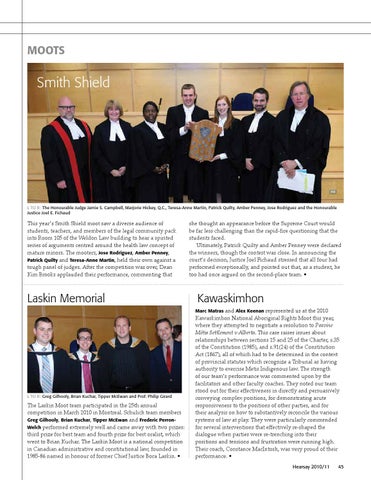MOOTS
Smith Shield
L TO R: The Honourable Judge Jamie S. Campbell, Marjorie Hickey, Q.C., Teresa-Anne Martin, Patrick Quilty, Amber Penney, Jose Rodriguez and the Honourable Justice Joel E. Fichaud
This year’s Smith Shield moot saw a diverse audience of students, teachers, and members of the legal community pack into Room 105 of the Weldon Law building to hear a spirited series of arguments centred around the health law concept of mature minors. The mooters, Jose Rodriguez, Amber Penney, Patrick Quilty and Teresa-Anne Martin, held their own against a tough panel of judges. After the competition was over, Dean Kim Brooks applauded their performance, commenting that
Laskin Memorial
L TO R: Greg Gilhooly, Brian Kuchar, Tipper McEwan and Prof. Philip Girard
The Laskin Moot team participated in the 25th annual competition in March 2010 in Montreal. Schulich team members Greg Gilhooly, Brian Kuchar, Tipper McEwan and Frederic PerronWelch performed extremely well and came away with two prizes: third prize for best team and fourth prize for best oralist, which went to Brian Kuchar. The Laskin Moot is a national competition in Canadian administrative and constitutional law, founded in 1985-86 named in honour of former Chief Justice Bora Laskin. •
she thought an appearance before the Supreme Court would be far less challenging than the rapid-fire questioning that the students faced. Ultimately, Patrick Quilty and Amber Penney were declared the winners, though the contest was close. In announcing the court’s decision, Justice Joel Fichaud stressed that all four had performed exceptionally, and pointed out that, as a student, he too had once argued on the second-place team. •
Kawaskimhon Marc Matras and Alex Keenan represented us at the 2010 Kawaskimhon National Aboriginal Rights Moot this year, where they attempted to negotiate a resolution to Peavine Métis Settlement v Alberta. This case raises issues about relationships between sections 15 and 25 of the Charter, s.35 of the Constitution (1985), and s.91(24) of the Constitution Act (1867), all of which had to be determined in the context of provincial statutes which recognize a Tribunal as having authority to exercise Metis Indigenous law. The strength of our team’s performance was commented upon by the facilitators and other faculty coaches. They noted our team stood out for their effectiveness in directly and persuasively conveying complex positions, for demonstrating acute responsiveness to the positions of other parties, and for their analysis on how to substantively reconcile the various systems of law at play. They were particularly commended for several interventions that effectively re-shaped the dialogue when parties were re-trenching into their positions and tensions and frustration were running high. Their coach, Constance MacIntosh, was very proud of their performance. • Hearsay 2010/11
45
